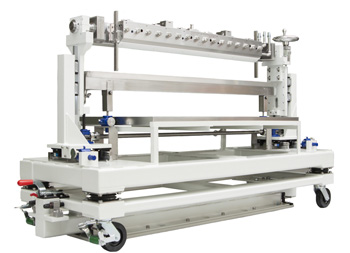Coating Matters | Discrete Coating Techniques & Equipment
- Published: May 29, 2012, By Mark Miller
If you'd like to hear from Mark Miller's own lips rather than read his column, titled "Coating Matters | Vacuum Discrete Coating Techniques & Equipment," click on his podcast below:
{mp3}discrete-coating-tech-voice{/mp3}
In the world of coating technology, most of the time and energy is spent on coating a moving web to create roll stock of fluid-coated and cured materials. Spending time on this area of the converting market is well placed, but how about those companies interested in coating a single discrete item?
Take a glass panel for example. There are many cases when a product requires a glass panel to be coated with a fluid, and the coating company needs to determine a method that optimizes results. What options are available? One method is to dip coat the glass panel, allowing for a thin fluid to evenly coat the glass panel on both sides.
 However, sometimes the coating company is interested in a thin even coat on one side of the glass panel. While you could mask the other side of the panel in a dip coating arrangement, a more elegant approach is to use a panel coating technology like a tabletop curtain coater. This equipment provides an option that is difficult to find in the open market. Plates and foils that need to be processed in a batch versus continuous process may want to consider this technology.
However, sometimes the coating company is interested in a thin even coat on one side of the glass panel. While you could mask the other side of the panel in a dip coating arrangement, a more elegant approach is to use a panel coating technology like a tabletop curtain coater. This equipment provides an option that is difficult to find in the open market. Plates and foils that need to be processed in a batch versus continuous process may want to consider this technology.
In a previous position, I was involved in developing a similar technology that failed to find investing interest, but the demands of the current electronics and optics markets are requiring panel coating technology more than ever. The keys to optimized coating of discrete panels include precision flatness of metal manufacturing, tight tolerance of the panel movement mechanisms, and fluid delivery that is consistent and metered.
Panel coating also has the advantage of producing higher precision “hand spreads” for laboratory development. For products that end up being roll coated, the panel coater still can provide some benefits at the laboratory scale. My early years were spent pulling paper and foils under a comma coater at precision speeds [sic] by hand. A mechanized panel coater would allow better translation of the fluid coating completed at the laboratory level to be scaled to the pilot and production scale.
With a well-designed panel coater, the fluid delivery system would limit the amount of fluid required to produce a sample. Instead of the lack of precision produced by a hand spread, an optimized slot die allows the researcher to have high precision coating with a method that can be scaled up to production size and an economical method of coating with an internal distribution system that provides low material consumption.
Modern coating liquids are both rare and expensive, so conservation is key for new product developments. With a small sample size, the chemist can develop non-optimized fluids to test without worrying about the large cost of production for a pilot scale run.
So, if you have been hemming and hawing about what equipment to use to develop new coating technologies at the laboratory scale, or are looking for a production answer for discrete panel coating for thin fluid coatings, your answer is here. One option that exists is a tabletop curtain coater. It sure beats the less-than-perfect “hand spread” technique!
Roll-to-roll coating industry expert Mark Miller, owner of Coating Tech Service, has 14+ years of slot die coating experience and troubleshooting. Contact him at 715-456-9545; This email address is being protected from spambots. You need JavaScript enabled to view it.; www.coatingtechservice.com.




